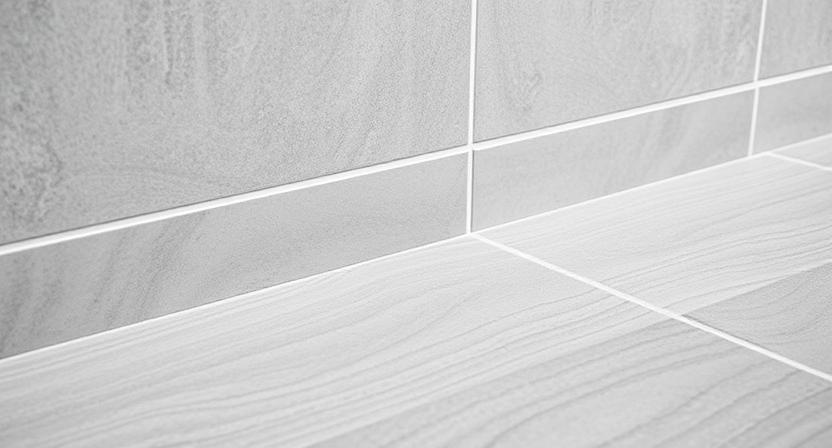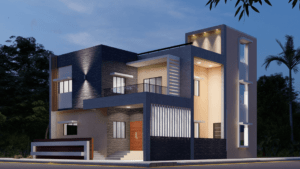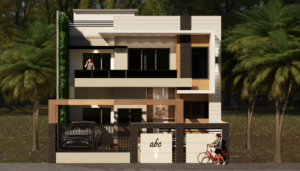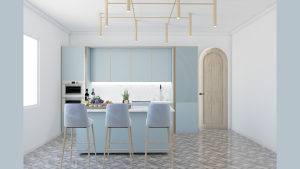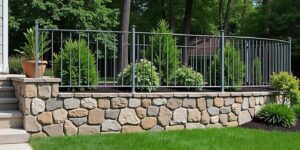When building or designing a home, you often focus on big things like flooring, walls, or ceilings. But small details matter too and skirting is one of those small but important elements in construction that you shouldn’t overlook.
Let’s understand what skirting is, why it’s used, its types, materials, pros and cons, applications, cost, and more.
Table of Contents
ToggleWhat is Skirting in Construction?
Skirting in construction is a strip of material usually wood, tile, PVC, or metal installed along the bottom edge of a wall where it touches the floor. Its main purpose is to cover the joint or gap between the wall and the floor. This not only improves the look of the room by giving it a clean and finished appearance but also protects the lower part of the wall from everyday damage.
For example, when you sweep, mop, or move furniture, the base of the wall is likely to get scuffed, scratched, or dirty. Skirting acts like a shield to prevent that. It also hides small imperfections, wiring, or uneven flooring edges that may be visible where the wall meets the floor.
In simple words, skirting is both functional and decorative it protects and enhances your interiors.
Skirting Meaning in Construction
In construction terms, skirting acts as a protective barrier. When you mop the floor or drag furniture around, the bottom of the wall is often at risk of getting dirty, scratched, or chipped. Skirting prevents that from happening.
It also hides uneven floor edges, wiring, or small gaps between the floor and wall.
Types of Skirting in Construction
Skirting comes in different styles, and the type you choose can change the overall look of your interior. These types are usually based on their shape, design, and how they are installed. Let’s look at some common ones:
1. Pencil Skirting
What it is: A very thin, narrow strip of skirting.
Where it’s used: Ideal for modern, minimalistic interiors where you want a neat look without drawing attention to the skirting.
Why choose it: It adds a touch of elegance without taking up much space. Often used in luxury homes or offices for a clean finish.
2. Flush Skirting
What it is: This skirting is installed at the same level as the wall, so it doesn’t stick out.
Where it’s used: Perfect for homes or spaces that need a sleek, seamless appearance.
Why choose it: It’s easy to clean, doesn’t collect dust on edges, and gives a smooth transition between the wall and the floor.
3. Recessed Skirting
What it is: Installed slightly inside the wall, so it appears sunken.
Where it’s used: Common in modern architecture and designer homes.
Why choose it: It keeps the wall edge protected without being too visible, and it prevents furniture from hitting the wall.
4. Bullnose Skirting
What it is: This type has a rounded top edge like a curve or “nose.”
Where it’s used: Suitable for homes with children or where you want a softer, more decorative look.
Why choose it: The rounded edge prevents injury from sharp corners and gives a stylish yet safe finish.
5. Double-Layered Skirting
What it is: Made by placing two layers of skirting boards, one over the other, with a step or offset design.
Where it’s used: Often seen in classic, royal, or traditional interiors.
Why choose it: It gives a bold, decorative appearance and adds a sense of depth to the room. Often painted in contrast or highlighted for effect.
Each type of skirting has its own look and purpose. Choosing the right one depends on your interior style, space usage, and personal preference.
Variety of Materials Used in Skirting
Skirting boards can be made from different materials based on the need, style, and budget:
1. Wood
Looks warm and natural.
Comes in many designs and finishes.
Needs regular maintenance to avoid termite or moisture damage.
2. MDF (Medium-Density Fiberboard)
A budget-friendly alternative to wood.
Easy to paint and install.
Not suitable for wet areas.
3. PVC (Polyvinyl Chloride)
Waterproof and termite-resistant.
Low maintenance and cost-effective.
Comes in plain or wood-like textures.
4. Tile
Matches the flooring perfectly.
Common in Indian homes.
Strong and durable, but heavier to install.
5. Marble or Granite
Premium finish, commonly used in high-end homes and offices.
Strong and long-lasting.
Expensive and needs careful handling during installation.
6. Stainless Steel or Aluminum
Industrial or modern look.
Durable and easy to clean.
More expensive than basic options.
Advantages of Skirting in Construction
Protects the wall: Stops damage from mopping, vacuuming, or furniture.
Covers imperfections: Hides rough wall edges and floor gaps.
Adds beauty: Gives a complete and clean look to a room.
Easy cable management: Hollow skirting can hide electrical wires neatly.
Low maintenance: Keeps the lower part of walls from catching dust or stains.
Disadvantages of Skirting in Construction
Takes space: Some types stick out and reduce room space slightly.
Extra cost: Adds to the overall construction or renovation budget.
Cleaning gaps: If not sealed properly, dirt can accumulate in gaps behind the skirting.
Material issues: Wooden skirting can swell in moisture; metal can rust if not coated well.
Applications of Skirting in Construction
Skirting is used in many areas inside and outside a building:
Living rooms and bedrooms – for a neat look and wall protection.
Kitchens and bathrooms – mostly tile or PVC skirting to resist water and stains.
Offices and hotels – for hiding electrical wiring and improving decor.
Staircases – prevents damage along the sides of stairs.
Skirting in Construction Cost
The cost of skirting depends on the material, design, and area covered. Here’s a general idea:
| Material | Approximate Cost per Running Foot (₹) |
|---|---|
| MDF | ₹20 – ₹50 |
| PVC | ₹30 – ₹60 |
| Wooden | ₹80 – ₹200 |
| Tile | ₹60 – ₹150 |
| Granite/Marble | ₹100 – ₹300 |
| Metal | ₹100 – ₹250 |
Note: These are just rough estimates. Labor and design complexity can affect the final price.
Conclusion
Skirting in construction might seem like a small detail, but it plays a big role in both the appearance and maintenance of your home or building. From protecting walls to adding design value, it’s a smart choice for any type of space.
Whether you prefer sleek flush skirting or rich marble finishes, picking the right material and style will improve both looks and functionality.
Need help choosing the right skirting or finishing touches for your home?
At SmartScale House Design, we create custom home plans with smart, stylish, and practical design elements including skirting, flooring, and more. Whether you’re building new or renovating, our expert team is here to guide you every step of the way.
Contact us today and let’s bring your dream home to life with smart design solutions that fit your style and budget.
FAQs
1. What is skirting construction?
Skirting construction refers to the process of installing a narrow strip of material typically wood, PVC, MDF, ceramic, or stone—at the bottom of a wall where it meets the floor. This strip, often called a skirting board or baseboard, acts as a protective and decorative barrier. It is usually installed after flooring is laid and helps create a neat junction between the wall and the floor.
2. What is the purpose of skirting?
Skirting serves multiple purposes, both practical and aesthetic:
-
Protection: It protects the bottom of the wall from damage caused by furniture, vacuum cleaners, brooms, or mopping. This helps prevent scuff marks, dents, and stains.
-
Concealment: It hides uneven edges where the wall meets the floor, covers construction gaps, and can also be used to conceal wiring or small pipes.
-
Visual finish: Skirting gives a clean, finished appearance to a room by providing a visual break between the wall and floor. It can enhance the overall interior design, especially when chosen in a complementary color or material.
3. What is the use of skirting?
Skirting is used to:
-
Prevent damage to the lower parts of interior walls due to daily activities or furniture movement.
-
Conceal imperfections at the joint between the wall and floor, including uneven surfaces or paint lines.
-
Hide electrical cables or internet wires running along the floor.
-
Enhance the aesthetic appeal of a room by adding a stylistic border.
4. What is skirting in a floor?
Skirting in a floor refers to the border material installed along the perimeter where the floor meets the wall. While not part of the floor itself, it plays a critical role in blending the floor and wall visually and functionally. The skirting acts as a transition piece that covers gaps, protects wall surfaces, and contributes to the room’s design.
5. What is the purpose of skirtings?
Skirtings have both functional and decorative purposes:
-
Functional: They protect the base of the wall from physical damage and wear, cover gaps or construction flaws, and provide a pathway to conceal cables.
-
Decorative: Skirtings can add contrast, depth, or continuity to a room’s design. They can be matched with the flooring for uniformity or styled differently to create visual interest.
6. Where is skirting used?
Skirting is used in almost all types of interior spaces, including:
-
Residential areas: Living rooms, bedrooms, kitchens, and hallways often include skirting to protect walls and enhance the appearance of the space.
-
Bathrooms: Water-resistant skirting (like tile or PVC) may be used to prevent water damage and mold growth at the wall base.
-
Commercial and public buildings: Offices, hotels, schools, and hospitals often include skirting for both hygiene and aesthetic reasons.
-
Staircases and corridors: Skirting helps protect walls in narrow spaces where there’s frequent movement.
Wherever there’s a wall-to-floor junction, skirting can be used to provide protection and a cleaner finish.

